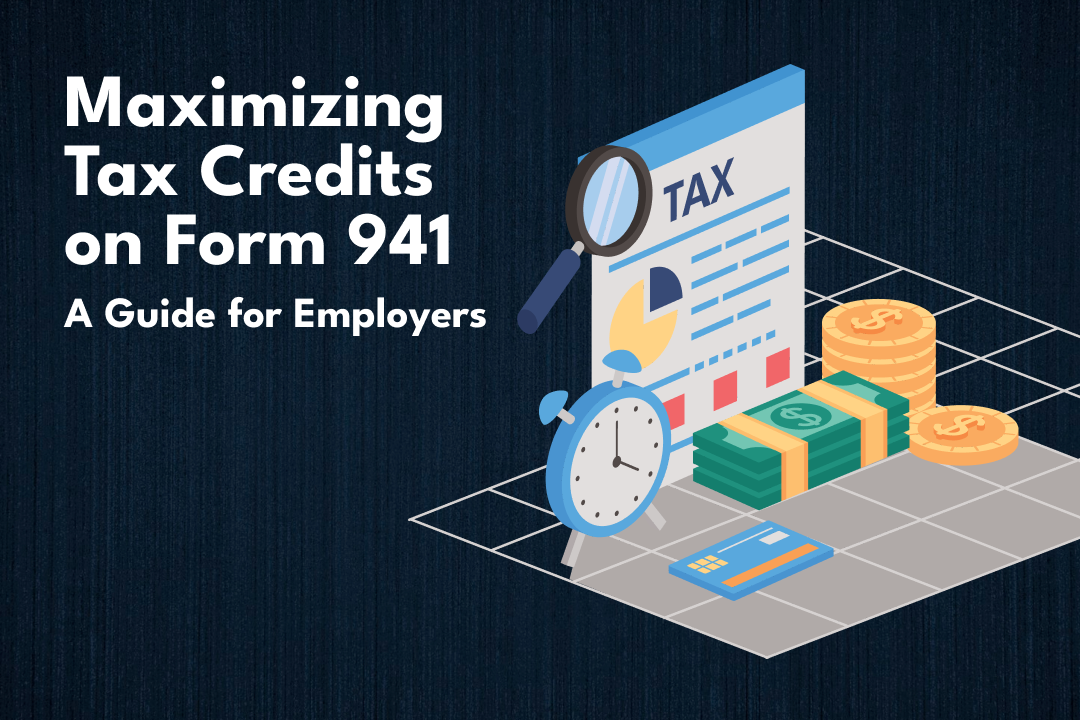Unlock Hidden Savings and Supercharge Your Business! Discover the secrets to maximizing tax credits on Form 941 with our comprehensive guide. From understanding the power of tax credits to exploring eligibility criteria and implementing smart strategies, we’ll show you how to keep more money in your pocket while staying compliant. Don’t miss this opportunity to optimize your financial game plan and advance your business!
Are you tired of dreading tax season, wondering if there’s any way to alleviate the financial burden it brings? Say goodbye to tax-related woes and hello to financial empowerment! Welcome to our comprehensive guide on Maximizing Tax Credits on Form 941, specially crafted for employers like you.
As we unveil the world of tax credits, you’ll discover the hidden gems that can revolutionize your business’s bottom line. From understanding the symbiotic relationship between tax credits and Form 941 to exploring their vast benefits, we’re here to transform your tax experience.
Prepare to embark on a journey of savings, efficiency, and newfound financial freedom. It’s time to unlock the full potential of your business with the power of tax credits!
Related Blog Post: All You Need To Know About IRS Form 941: An End-To-End Guide
Understanding Tax Credits and Their Impact on Form 941
Tax credits are powerful incentives the government provides to directly reduce a business’s tax liability. Unlike tax deductions, which lower taxable income, tax credits offer a dollar-for-dollar reduction in taxes owed. These credits can be game-changers for employers, providing opportunities to save money and invest in their businesses.
Types of Tax Credits Available to Employers
Let’s discuss the different types of tax credits available to employers.
Work Opportunity Tax Credit (WOTC)
The WOTC encourages employers to hire individuals from specific target groups that face barriers to employment. These groups may include veterans, ex-felons, long-term unemployed individuals, and recipients of certain government assistance programs. The credit amount varies based on the targeted employee’s wages and hours worked.
Employee Retention Credit (ERC)
Introduced in response to the COVID-19 pandemic, the ERC incentivizes employers to retain their employees during challenging economic times. Eligible employers can claim a credit against qualified wages paid to employees, helping to offset some of the costs of keeping their workforce intact.
Research and Development (R&D) Tax Credit
Designed to promote innovation and technological advancement, the R&D Tax Credit provides a credit for qualifying research and development activities. It allows businesses engaged in research-related endeavors to receive a percentage of eligible expenses as a credit.
Family and Medical Leave Act (FMLA) Tax Credit
The FMLA Tax Credit encourages employers to offer their employees paid family and medical leave. Employers who provide eligible employees with paid leave can claim a credit for a percentage of the wages paid during the leave period.
Small Business Health Care Tax Credit
Small businesses that offer health insurance coverage to their employees may qualify for the Small Business Health Care Tax Credit. This credit is intended to alleviate some of the costs associated with providing healthcare benefits to employees.
Renewable Energy Tax Credits
Businesses investing in renewable energy projects, such as solar, wind, or geothermal energy, may be eligible for various tax credits to support and incentivize clean energy initiatives.
Related Blog Post: Common Errors to Avoid on Form 941: Tips for Accurate Filing
How Tax Credits Reduce Tax Liability and Increase Cash Flow
Tax credits are crucial in reducing tax liability and increasing business cash flow; unlike tax deductions, which lower taxable income, tax credits directly reduce the amount of taxes owed, dollar-for-dollar. This unique characteristic makes tax credits immensely valuable for employers, offering substantial financial benefits. Let’s explore how tax credits work to reduce tax liability and boost cash flow:
Dollar-for-Dollar Reduction in Taxes
When an employer claims a tax credit, the credit amount is subtracted directly from the total tax owed. For example, if a business owes $10,000 in taxes and is eligible for a $5,000 tax credit, the total tax liability is reduced to $5,000. This results in significant savings for the business, as they pay less in taxes compared to their original tax bill.
Potential Carryover or Refund
Sometimes, tax credits can create a surplus, where the credit amount exceeds the tax liability for a specific year. The excess credit can be carried forward to future years, reducing tax liability. Alternatively, the business may be eligible for a tax refund if the credit exceeds current and future tax liabilities. This refund acts as a direct cash flow injection into the business, providing additional capital for investments, expansion, or operational improvements.
Enhancing Profitability and Competitiveness
Reducing tax liability through tax credits allows businesses to retain more earnings, ultimately enhancing their profitability. With improved cash flow, businesses can invest in research and development, upgrade equipment, increase employee benefits, or expand their product and service offerings. This increased flexibility and ability to invest in the company can boost competitiveness and position the business for long-term success.
Encouraging Business Investment and Job Creation
Certain tax credits, such as the Work Opportunity Tax Credit (WOTC), incentivize businesses to hire and retain employees from specific target groups. By providing financial benefits for hiring individuals facing barriers to employment, tax credits stimulate job creation and contribute to a diverse and inclusive workforce.
Related Blog Post: Understanding Form 941 Payment Methods: A Guide for Employers
Eligibility Criteria And Requirements For Each Tax Credit
In this section, we will discuss the eligibility criteria and requirements for each tax credit.
Work Opportunity Tax Credit (WOTC)
To qualify for the WOTC, employers must hire individuals from specific target groups, such as veterans, ex-felons, long-term unemployed individuals, and recipients of certain government assistance programs. Each target group has its eligibility criteria, and employers must obtain certification from the appropriate state agency or Department of Labor before claiming the credit.
Employee Retention Credit (ERC)
The ERC was introduced in response to the COVID-19 pandemic and has specific eligibility criteria based on business operations changes during certain periods. Eligible employers must meet various requirements, including experiencing a significant decline in gross receipts or having operations partially or fully suspended due to government orders. The credit amount is calculated based on qualified employee wages during eligible periods.
Research and Development (R&D) Tax Credit
The R&D Tax Credit is available to businesses engaged in qualified research activities that seek to improve or develop new products, processes, or software. Eligibility criteria depend on the nature and extent of the research activities, and the credit amount is determined by calculating a percentage of qualifying research expenses.
Family and Medical Leave Act (FMLA) Tax Credit
Employers providing paid family and medical leave to eligible employees may qualify for the FMLA Tax Credit. Eligibility criteria include offering leave that meets specific requirements and paying qualified wages during the leave period. The credit amount is a percentage of the wages paid, subject to a maximum limit.
Step-by-Step Guide To Determine Eligibility And Calculate Potential Credits
Let’s discuss the step-by-step guide to determine eligibility and calculate potential credits.
Identify Eligible Activities and Employees
For each tax credit, review the eligibility criteria and identify which activities or employees meet the required conditions. For example, determine if your business hires individuals from the target groups specified under the WOTC, or if your research and development activities qualify for the R&D Tax Credit.
Gather Necessary Documentation
Accurate record-keeping is crucial for claiming tax credits. Collect all relevant documentation, such as employee records, certifications, and financial data, to support your eligibility claims.
Calculate Qualified Expenses and Wages
Calculate the total qualified amounts for tax credits based on expenses or wages. This may involve tracking research-related expenditures for the R&D Tax Credit or determining eligible wages for the Employee Retention Credit.
Consult with Tax Professionals
Navigating tax credits can be complex, and consulting with tax professionals or accountants can be invaluable. They can help ensure accurate calculations, compliance with IRS requirements, and timely submission of necessary forms.
Complete and File Appropriate Forms
Once you have determined your eligibility and calculated potential credits, complete the relevant tax forms, such as Form 5884 for the WOTC or Form 941 for the Employee Retention Credit. Follow IRS guidelines and instructions for each credit to avoid errors in reporting.
Strategies for Maximizing Tax Credits on Form 941
Tax credits present exciting opportunities for employers to save money and drive growth. In this section, we’ll explore strategic approaches to maximize tax credits on Form 941, ensuring businesses capitalize on all available benefits:
Proactive Workforce Planning to Leverage WOTC and Other Hiring-Related Credits
By incorporating proactive workforce planning, employers can identify opportunities to capitalize on the Work Opportunity Tax Credit (WOTC) and other hiring-related credits. Understanding the specific target groups that qualify for the WOTC and aligning recruitment strategies can lead to significant savings. Smart hiring decisions can simultaneously benefit both the business and the community.
Understanding the Impact of COVID-19 on the ERC and Maximizing Its Benefits
The Employee Retention Credit (ERC) became a vital lifeline during the pandemic. Employers must stay updated on the ever-changing ERC regulations and ensure they meet the eligibility criteria to claim this valuable credit. Maximizing ERC benefits involves understanding which periods are eligible, calculating qualified wages, and taking advantage of any expansions in credit provisions.
Utilizing R&D Tax Credits to Incentivize Innovation and Research Activities
Innovation is the driving force behind business growth. Employers engaged in research and development activities can tap into R&D Tax Credits to incentivize and support innovation. By tracking and documenting qualifying expenses and activities, businesses can reap substantial rewards and invest in cutting-edge advancements.
Complying with FMLA Regulations While Maximizing Available Tax Credits
Employers providing employees paid family and medical leave can leverage the FMLA Tax Credit. Strategic FMLA planning ensures compliance with regulations while maximizing available tax credits. By offering eligible employees the opportunity for paid leave, employers enhance employee morale, retention, and productivity, all while enjoying valuable tax benefits.
Accurate Documentation and Record-Keeping to Claim Credits Effectively
Accurate documentation and record-keeping are the foundation of successful tax credit claims. Employers must maintain well-organized records, including employee certifications, research-related expenses, and evidence of FMLA compliance. Utilizing digital tools and seeking professional guidance can streamline this process, avoiding errors and potential credit denials.
By carefully assessing eligibility criteria and following a step-by-step guide, employers can confidently claim tax credits they qualify for, reducing their tax liability and maximizing the financial benefits for their businesses. Properly documenting and calculating credits is essential to ensure compliance and maximize these valuable incentives.



